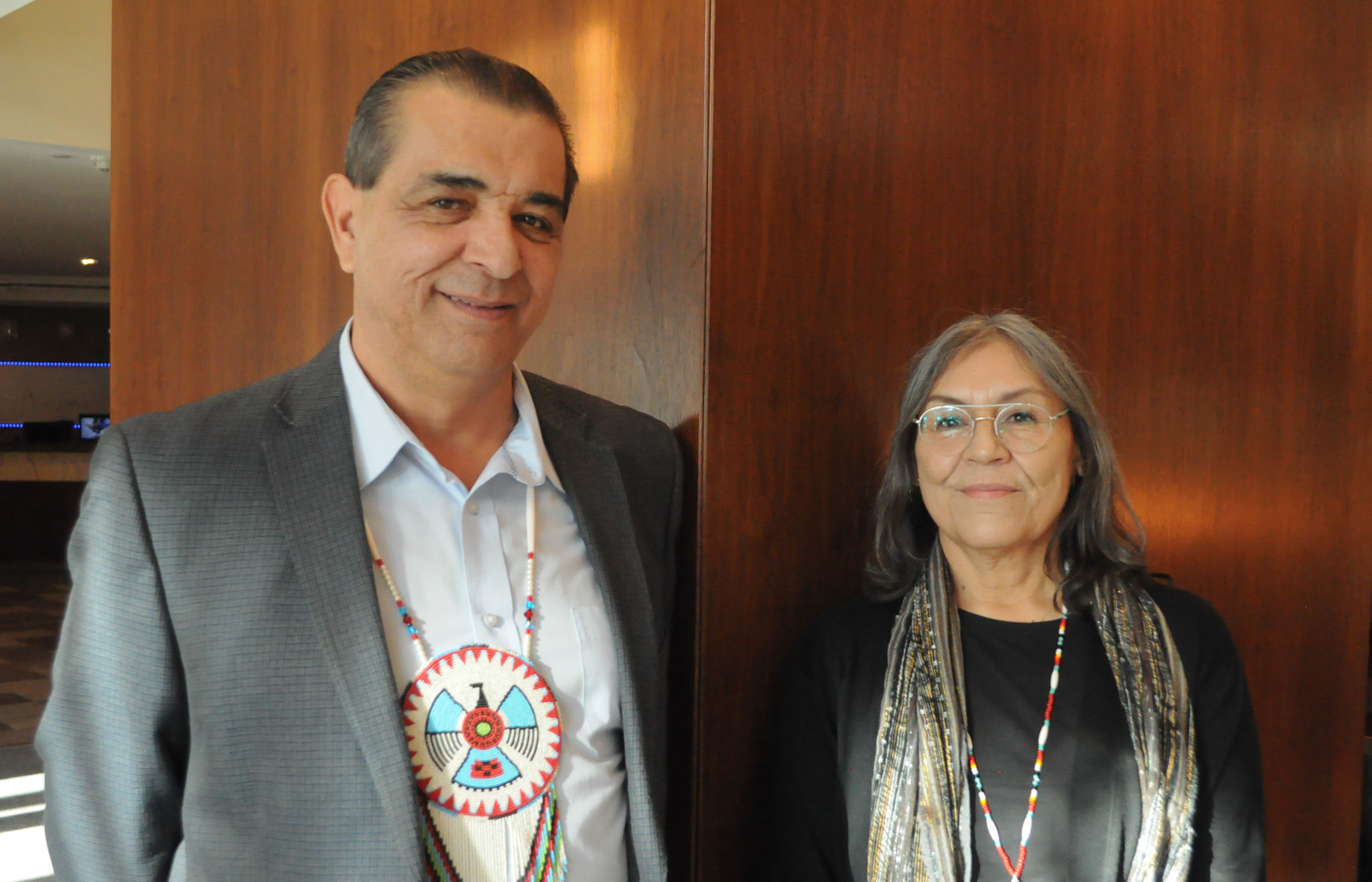By Matteo Cimellaro |

Lester Anoquot, former chief of Saugeen First Nation, and Veronica Smith, chief of the Chippewas of Nawash Unceded First Nation, attend a nuclear conference in Ottawa in February.
Two First Nations near the proposed expansion of Canada’s largest nuclear power plant will not support any new projects until there is a solution to the nuclear waste problem on their territory, the Saugeen Ojibway Nation wrote in a letter to its membership obtained by Canada’s National Observer.
Bruce Power, the operator of the Bruce Nuclear Generating Station, will have to demonstrate safe nuclear waste management, the Ontario government said in a press release announcing the province’s first large-scale nuclear development in three decades. However, the release stopped short of mentioning the development of a deep geological repository set to be the solution for long-term nuclear waste storage for the country.
The Saugeen Ojibway Nation, composed of the Saugeen First Nation and the Chippewas of Nawash Unceded First Nation, is one of two possible hosts for the Nuclear Waste Management Organization’s (NWMO) proposed nuclear waste facility, along with Ignace, Ont., located 250 kilometres northwest of Thunder Bay.
The NWMO, a Canadian non-profit tapped to address the disposal of used nuclear fuel, will select a site to store Canada’s nuclear waste roughly 500 metres underground — as deep as the CN Tower is high — in a geological repository in March 2024.
“Until the Saugeen Ojibway are comfortable on the plan on how we're going to resolve that waste issue, it's really hard for us to buy into 100 per cent of what the province is doing,” Veronica Smith, chief of the Chippewas of Nawash Unceded First Nation, told Canada’s National Observer.
There will be compensation for the communities chosen to host the deep geological repository, Smith added. But it’s unclear if host First Nations might benefit from a nuclear waste facility revenue-sharing model or a lump sum payment. Those conversations haven’t even started between Saugeen Ojibway Nation and the NWMO, Smith said.
It’s also unclear if community members of both First Nations will be comfortable with the NWMO’s plan for a nuclear waste facility. Smith notes community members are the ultimate decision-makers over a proposed agreement to host the waste facility, not the elected chief and council.
What people are reading

Climate action hits speed bump as Trudeau and Smith announce new working group
By John Woodside | News, Energy, Politics | July 7th 2023
Nishnawbe Aski Nation, the political organization that represents 49 First Nations in northern Ontario, has vehemently opposed building the waste facility in the North. In 2022, the organization passed a resolution stating concerns over watersheds that lead up into Hudson Bay.
However, Grand Council Treaty 3, which represents the First nations where Ignace is located, currently has relationship agreements with NWMO.
Within the northern First Nations, there are also worries a nuclear spill from transport trucks carrying waste could cut off the northern communities' winter road access, cutting a vital supply route to several communities.
Two First Nations near the proposed expansion of Canada’s largest nuclear power plant will not support any new projects until there is a solution to the nuclear waste problem on their territory. #BrucePower #onpoli #Ontario
“What is NWMO going to say if both communities say no?” Smith asked.
In its letter to membership, the Saugeen Ojibway Nation also wrote that it wants a resolution and reconciliation over the historical legacy issues of nuclear power on their territory.
In the 1960s, the Bruce Power Station, one of the largest nuclear power stations in the world, was constructed on Saugeen Ojibway Nation’s territory without consultation and consent.
Until recently, there was no revenue sharing between the nuclear power station and the nations.
Now, the Saugeen Ojibway Nation is set to benefit economically after striking a revenue-sharing agreement with Bruce Power, the private proprietor of the nuclear station, to share profits from a new medical isotope used in the treatment of prostate cancer.
— With files from Cloe Logan
Matteo Cimellaro / Canada’s National Observer / Local Journalism Initiative
Saugeen Ojibway Nation Statement On Exploring Bruce Power Site Expansion

Saugeen Ojibway Nation has made a statement with regard to this week’s announcement from the Ontario government in support of exploring the expansion of the Bruce Power nuclear generation site.
The statement is signed by both SON Chiefs, Veronica Smith, Chief of Chippewas of Nawash Unceded First Nation, and Saugeen First Nation Chief Conrad Ritchie.
“Today (July 5th) the Ontario Minister of Energy, Todd Smith will be announcing that the province intends to support a study by Bruce Power to see if the Bruce site is suitable for new nuclear development. The purpose of the study, and review by Canada, is to identify future projects that could meet Ontario’s energy needs. The study and assessment will take many, many years to complete.
“Leadership has been following this closely, and in a recent meeting with the minister, we made clear that although we understand the energy challenges faced by Ontario and the push to plan for new electricity projects, new nuclear projects present a serious challenge for SON and our people.”
“The Saugeen Ojibway Nation has also made it clear that any future decisions on nuclear must include the SON as central participants in the planning process. Ontario has committees to developing new projects only if they are right for the SON and the local communities. They have also recognized the SON must be partners in, and benefit fairly from any future projects in our Territory. Finally, we have stated clearly that SON will not support any new projects until the history of the nuclear industry on our Territory is resolved and there is a solution to the nuclear waste problems that is acceptable to SON and its People.”
“It is critical that our serious and ongoing concerns about the development of the nuclear industry in our Territory be properly addressed by government and industry. Commitments have been made, but now we need to see action. The long overdue resolution of the nuclear legacy issues must occur before any future project is approved. Similarly, we must also have a plan in place that has been agreed to by SON to deal with all current and future nuclear waste before any future projects could go ahead. There are issues that must be worked on in priority long before any new decision on new projects can be made.”
“The Chiefs and Councils have a deep and solemn responsibility to protect this Territory for our People and for all people that share our lands and waters. We take this responsibility very seriously and will continue to work with government and industry to make sure only good and sustainable projects are built and that the future of our People is protected.
“We will continue to provide you with updates on the many issues facing our People. Most importantly, we will bring you information about our progress in resolving legacy issues and dealing with the nuclear wastes in our territory. Finally, we will continue to work with Ontario and Canada to ensure that any study for nuclear is done in a way that protects our rights, interests and way of life and that SON’s voice is heard and respected.”
The Ontario government is racing to buy nuclear but won’t say how much it’s going to spend.
Just months after starting work on one of the world’s first small nuclear reactors, the province this week announced massive expansions at two nuclear plants, promising more than six gigawatts of new generation – which could power six million Enough to power homes. in the mid-2030s.
Including the three new small modular reactors (SMRs) in Darlington announced on Friday and the new full-size reactors in Bruce announced earlier in the week, the electricity grid will add about 50 percent more nuclear power than is currently online.
In both announcements, Energy Minister Todd Smith declined to say how much these new nuclear reactors would cost.
Critics of Queen’s Park say writing blank checks for nuclear power, which has a long history of cost overruns, is not in line with the government’s promise to keep electricity tariffs down.
“The people of this province want to know what will be the total cost of this project. More importantly, what will be the cost of the electricity generated from these reactors? Who is responsible for any budget excess?” NDP MPP Peter Tabuns said.
For 14 years, Ontario electricity customers paid a debt retirement surcharge on their electricity bills to pay off nearly $20 billion in stranded construction debt for the Darlington nuclear plant, the last nuclear project built in the province. Went way over budget and caused Ontario Hydro to go bankrupt.
SMR, which is supposed to be cheaper and faster to build than a full-sized nuclear plant, is still a relatively untested technology, and has not been put into commercial operation anywhere in the world.
Throughout their history, nuclear plants have faced increasing construction delays and cost overruns, while the cost of renewable energy such as wind and solar has declined rapidly. This has led many to question why Premier Doug Ford is investing in more expensive natural gas plants and nuclear power.
“Ontario is facing an energy crisis. Fortunately, solutions are right in front of us – cheap, safe, clean renewable energy like hydro, wind and solar that can be deployed quickly,” said Mike Schreiner, leader of the Green Party.
Last year, the International Energy Agency said that so far the cost of new solar power projects has declined, solar panels are now the cheapest form of energy in history. This has sparked a global renewables construction spree, where China will install more solar power this year than all the panels installed in the United States combined.
“Global investors are attracted to renewable energy because they are the cheapest, cleanest source of electricity generation. But instead of paying attention, the Ford government is moving in the opposite direction – hurting consumers, the economy and the climate in the process,” said Schreiner.
Smith said building the four SMRs simultaneously at Darlington would adopt a “fleet approach” to keep costs down and build up local expertise.
“Sharing common infrastructure among units will help us reduce costs. And the construction of four units provides more opportunities for Ontario companies to invest in expanding their operations to serve the growing SMR market.
OPG President and CEO Ken Hartwick said Ontario’s commitment to building the first four nuclear technology of its kind “really signals the pace of nuclear development for the future of the grid in Ontario.”
“In the long run, developing this built-in Ontario expertise will mean we can export our know-how to other jurisdictions in Canada and around the world.”
After two decades when more nuclear plants were shut down than built, the technology has attracted renewed interest as a climate change solution, as it could provide abundant carbon-free electricity.
However, critics point out that both building the plants and mining uranium for fuel are carbon-intensive. Furthermore, no long-term storage solutions have been developed to deal with the remaining radioactive waste.
After being elected in 2018, Ford canceled more than 700 renewable energy projects at a cost of $231 million, and the province, once a Canadian leader in building wind and solar power, hasn’t built any since. .
Last year, Alberta added 1.4 gigawatts of the 1.8 gigawatts of renewable energy produced in Canada, according to the Canadian Renewable Energy Association. Ontario added none.
Earlier this year, Ontario announced the expansion of two gas plants and upgrades to four others in an effort to meet short-term energy shortages, as demand begins to rise for the first time since 2005.
New industrial investment by electric vehicle and battery manufacturers, as well as increased public demand due to switching to EVs and electric heat pumps, means Ontario needs to more than double the amount of electricity it needs by 2050, according to the Independent Electricity System Operator. May need it. ,
And carbon-free electricity will be needed to comply with the federal government’s commitment to a coast-to-coast net-zero electricity grid by 2035.
An additional three SMRs are scheduled to come online between 2034 and 2036, subject to regulatory approval. The construction of the first is scheduled to be completed by 2028.
No comments:
Post a Comment